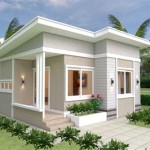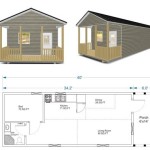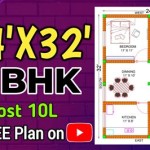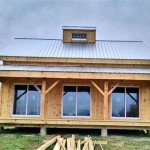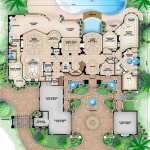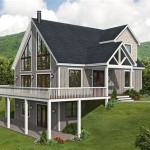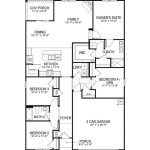Floor Plan Examples For Homes: A Comprehensive Guide
The floor plan is a fundamental architectural drawing depicting a home's layout as viewed from above. It illustrates the relationships between rooms, walls, doors, windows, and other structural elements. Understanding and interpreting floor plans is crucial for homeowners, prospective buyers, and contractors alike. They provide a visual blueprint for construction, renovation, and even interior design, allowing for informed decisions regarding space allocation, functionality, and aesthetics.
Floor plans are not simply lines on paper; they are a representation of living spaces, potential, and the future comfort of inhabitants. The type and complexity of a floor plan vary depending on the size and style of the home. This article explores different types of floor plan examples for homes, providing insights into their characteristics and suitability for various needs.
Open Concept Floor Plans: Embracing Space and Light
Open concept floor plans have gained significant popularity in recent years, characterized by the integration of multiple living areas, such as the kitchen, living room, and dining room, into a single, expansive space. This design aims to create a sense of spaciousness, promote social interaction, and maximize natural light penetration throughout the home.
The defining feature of an open concept floor plan is the minimal use of walls to divide these key living areas. Instead, furniture arrangement, changes in flooring, or subtle architectural details like columns or partial walls are employed to define distinct zones within the larger space. This creates a fluid and interconnected environment conducive to both daily living and entertaining.
Advantages of open concept floor plans include enhanced natural light, improved air circulation, and increased flexibility in furniture arrangement. The lack of walls allows for greater visual connection between family members and guests, fostering a sense of togetherness. They are particularly well-suited for modern lifestyles where informal gatherings and collaborative activities are common.
However, open concept floor plans also have potential drawbacks. Noise can travel easily throughout the space, which may be a concern for individuals who value privacy or require quiet areas for work or study. Additionally, maintaining a consistent aesthetic throughout the large, undivided space can be challenging, requiring careful consideration of color palettes, materials, and furniture styles.
Examples of open concept floor plans for different home types include:
*Single-story ranch homes:
Open concept designs are common in ranch-style homes, creating a seamless flow between the living room, dining area, and kitchen. This is particularly beneficial in smaller ranch homes, as it makes the space feel larger and more open. *Modern townhouses:
Many modern townhouses incorporate open concept living areas on the main floor, maximizing the usable space and creating a contemporary ambiance. The open layout often extends onto outdoor spaces like balconies or patios, further blurring the lines between indoor and outdoor living. *Loft apartments:
Loft apartments frequently feature completely open floor plans, with minimal or no interior walls. This allows residents to customize the space according to their individual needs and preferences, creating a unique and adaptable living environment.When considering an open concept floor plan, it is essential to assess one’s lifestyle and needs carefully. Factors to consider include household size, noise sensitivity, and desired level of privacy. Consulting with an architect or interior designer can help determine whether an open concept design is the right fit for a particular home and lifestyle.
Traditional Floor Plans: Defining Spaces and Maintaining Privacy
In contrast to open concept designs, traditional floor plans emphasize clearly defined rooms and distinct living areas. Walls are used to separate spaces, creating a sense of privacy and compartmentalization. This layout is often associated with more formal living arrangements and is favored by those who prefer a more structured and organized home environment.
A traditional floor plan typically includes a separate living room, dining room, kitchen, and bedrooms, each enclosed by walls and accessible through doorways. Hallways often connect the various rooms, providing a clear circulation path throughout the home. This design allows for greater noise control and privacy, making it suitable for families with diverse needs and preferences.
Advantages of traditional floor plans include increased privacy, noise reduction, and a sense of defined purpose for each room. The separate living room can serve as a formal entertaining space, while the dining room provides a dedicated area for family meals. The kitchen is typically enclosed, containing cooking odors and minimizing noise from appliances.
However, traditional floor plans can also feel more restrictive and less conducive to social interaction than open concept designs. The walls can limit natural light penetration, resulting in darker and less airy spaces. Furthermore, the compartmentalized layout may not be ideal for modern lifestyles where informal gatherings and open communication are valued.
Examples of traditional floor plans for different home types include:
*Colonial-style homes:
Colonial homes typically feature a formal living room and dining room at the front of the house, with the kitchen and family room located at the rear. The bedrooms are usually located on the second floor, separated from the main living areas. *Victorian-era homes:
Victorian homes often have a complex floor plan with multiple rooms on each floor, including parlors, libraries, and formal dining rooms. These homes are characterized by intricate details, ornate trim, and a sense of grandeur. *Bungalow homes:
While some bungalows may incorporate open concept elements, many feature a more traditional layout with separate living rooms, dining rooms, and bedrooms. The smaller size of bungalow homes often necessitates a more compact and functional floor plan.When considering a traditional floor plan, it is important to assess one’s lifestyle and priorities. Factors to consider include the need for privacy, the desire for formal living spaces, and the importance of noise control. A traditional floor plan may be a good choice for those who value order, structure, and a sense of defined purpose for each room in the home.
Split-Level Floor Plans: Utilizing Vertical Space
Split-level floor plans are characterized by multiple levels that are offset from each other, typically by a half-story. This design is often used to maximize space on smaller lots or to create distinct living zones within the home. The split-level arrangement can provide a sense of privacy and separation between different areas, such as the bedrooms and the recreation area, while still maintaining a cohesive overall design.
A typical split-level floor plan includes three or more levels. The main level usually contains the living room, dining room, and kitchen. A half-story up from the main level is frequently where the bedrooms are located, providing a quieter zone away from the main living areas. A half-story down from the main level often houses a recreation room, family room, or garage. Some split-level homes may also have a basement level.
Advantages of split-level floor plans include efficient use of space, creation of distinct living zones, and potential for lower construction costs compared to multi-story homes. The offset levels can provide a sense of privacy and separation without requiring a large footprint. Split-level homes can also be well-suited for sloping lots, as they can be adapted to the terrain.
However, split-level floor plans can also have certain drawbacks. The multiple levels can be challenging for individuals with mobility issues, as they require frequent use of stairs. The layout can also feel somewhat disjointed, with limited visual connection between the different levels. Furthermore, furniture placement can be tricky in some split-level homes due to the varying ceiling heights and room sizes.
Examples of split-level floor plans include:
*Side-split homes:
Side-split homes have the entrance on one side, with a short flight of stairs leading up to the bedrooms and another short flight leading down to the recreation area. *Back-split homes:
Back-split homes have the entrance at the back, with a similar arrangement of levels as the side-split, but with the main living areas located at the front of the house. *Four-level split homes:
Four-level split homes have an additional level, which may be used for a finished basement, an additional bedroom, or a home office.When considering a split-level floor plan, it is important to assess one’s lifestyle and physical abilities. Factors to consider include the number of family members, any mobility limitations, and the desired level of connection between the different living areas. A split-level floor plan may be a good choice for those who value efficient use of space and distinct living zones, but careful consideration should be given to the potential challenges of navigating multiple levels.
These floor plan examples represent a small selection of the many possibilities available in home design. Each type offers benefits and drawbacks, making it essential to meticulously consider individual needs, lifestyle, and site constraints before making decisions during the design process. Seeking professional architectural advice can significantly contribute to achieving a floor plan that maximizes comfort, functionality, and overall satisfaction.

12 Examples Of Floor Plans With Dimensions

Ready To Use Sample Floor Plan Drawings Templates Easy Blue Print Floorplan Ezblueprint Com

Floor Plans Types Symbols Examples

House Floor Plan Template

Free Floorplan Template Inspirational Home Plans Sample House Floor Simple Plan Layout

Home Floor Plans House Plan Drawings

Ready To Use Sample Floor Plan Drawings Templates Easy Blue Print Floorplan Ezblueprint Com

Free Editable Open Floor Plans Edrawmax

Example Of An Apartment Floor Plan On Which The Residents Have Drawn Scientific Diagram

Ready To Use Sample Floor Plan Drawings Templates Easy Blue Print Floorplan Ezblueprint Com Drawing Plans How

